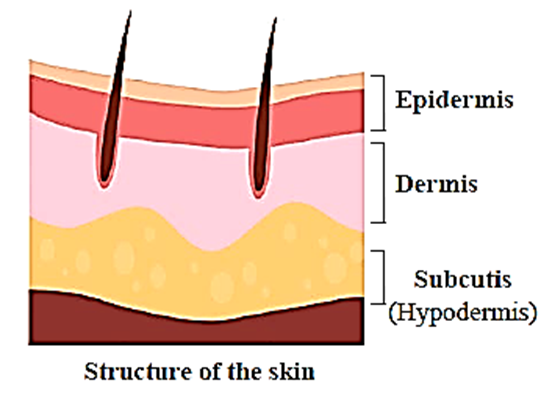Our Skeletal System and the Skin
Based on Maharashtra Board Class 6th General Science Chapter 8
Notes
Topics to be learn :
|
Skeleton : Skeleton is a protective shell for human body. Skeletal system is made of different bones of various shapes and structure.
- Different organs present in the body are protected within body cavity.
- All the internal organs are well protected due to skeleton.
- Skeletal system is formed of all the bones of the body along with the associated cartilages.
- If a bone is broken it is called a fracture. A fractured bone causes severe and unbearable pain. The part of body having a fracture, swells immediately.
- The patient with a fractured bone is immediately taken to a doctor. The fractured part is kept immobilized and ‘X-ray’ image is taken.
- Due to ‘X-ray‘ investigation exact damage and place of fracture is understood. The proper treatment is then given to the patient.
- ‘X-rays’ were discovered by Wilhelm Conrad Roentgen.
Functions of skeletal system :

The structure of the bones :
Types of bones : According to the shape, bones are of four types, i.e. (1) Flat bone (2) Small bones (3) Irregular bones (4) Long bones.

The human skeletal system : The human skeletal system divided into two parts :
- Axial skeleton : The axial skeleton consists of the skull, the spine and the rib cage. These are situated symmetrically along the central vertical axis of the body.
- Appendicular skeleton : The appendicular skeleton is made up of the bones of the upper and lower limbs (arms and legs) on either side of the central axis.
The skeleton is made up of the following bones : Axial skeleton: 1)Skull : Skull is the first part of the axial skeleton that is made up of 22 bones. 2) Rib cage : The rib cage is the cage like structure in the chest region. 3) Vertebral columns / Spine : The spine is formed by padlock-shaped bones placed straight one above the other. 4) Appendages : The appendicular skeleton is made up of bones of arms and legs along with upper and lower girdle which joins the arms and legs to the torso. There are all types of joints in the appendicular skeleton due to which we are able to make all possible movements of our limbs.
Joints : The places where two or more than two bones are connected to each other are called joints. Joints are of two types.
- Movable Joint : Bones at joints can move. Examples : bones of arms and legs
- Immovable Joint : Bones at joints cannot move. Example : bones of the skull. (Other than the lower jaw)
Types of movable joints :

Skin : Skin is the external outermost covering of the body
- The skin is an important and large organ of all living things.
- The skin is an important sensory organ of the body.
- It is one of the five sense organs of the body.
- It gives us the sense of touch.
- The hair and nails at the tips of fingers and toes are also part of the skin.
The structure of the skin : Two main layers of skin : Outermost epidermis and inner is dermis.

Functions of the skin :
Regulation of body temperature : When we walk or play in the hot sun, the temperature of our body may rise. But due to automatic regulation, the sweat glands get activated and we start sweating. We also feel thirsty. The sweat glands are present in the dermis layer of the skin. The sweat helps to reduce the increased temperature. Our body temperature is normally regulated approximately at 37 °C or 98.4° F.
Effect of age on skin : With the old age, the proportion of fat beneath the subcutaneous layer of the skin reduces. Due to this previously taut skin shrinks. Wrinkles thus appear on the skin.
Melanin : Melanin is the pigment which decides the colour of our skin and
Useful links of Class 6th General Science :
| Main Page : Class 6th MSBSHSE – General Science - All chapters notes, solutions, videos, test, pdf.
Previous Chapter : Chapter-7-Nutrition and Diet - Online Notes Next Chapter : Chapter-9-Motion and Types of Motion - Online Notes |